#Highgate House of Horror
Explore tagged Tumblr posts
Text
An article about the Highgate days...





Sunday Times, 'Time and place: Reece Shearsmith', 5 April 2015
#reece shearsmith#steve pemberton#tlog#the league of gentlemen#article is from#2015#highgate house of horror
64 notes
·
View notes
Text
















Happy Birthday Reeson Wayne Shearsmith
#Reece Shearsmith#The League of Gentlemen#Psychoville#Inside No 9#My Gifs#Geoff Tipps#Ross Gaines#Brian Macmillan#Jeremy Goode#Tom & Jerri#Wuthering Heist#TLC#Catterick#See How They Run#Saltburn#Highgate House of Horror#TLOG#IN9
119 notes
·
View notes
Text
Just watched Highgate House of Horror and uhh...
Gents, what the fuck? (Affectionate)
25 minutes of pure insanity but also absolutely has the feel of an earlier more unrefined version of TLoG, truly toeing the lines between horror and absurdity (like reece dismembering mark while tales of the vienna waltz plays)
Also living proof that these guys specialise in creating Fucked Up Shit™️ and that's why we love them
Plus it was nice to see Jeremy on screen acting!!
#honestly cant help but love it i wont lie#highgate house of horror#reece shearsmith#steve pemberton#mark gatiss#jeremy dyson#the league of gentlemen
35 notes
·
View notes
Text
Pov you're texting me again:
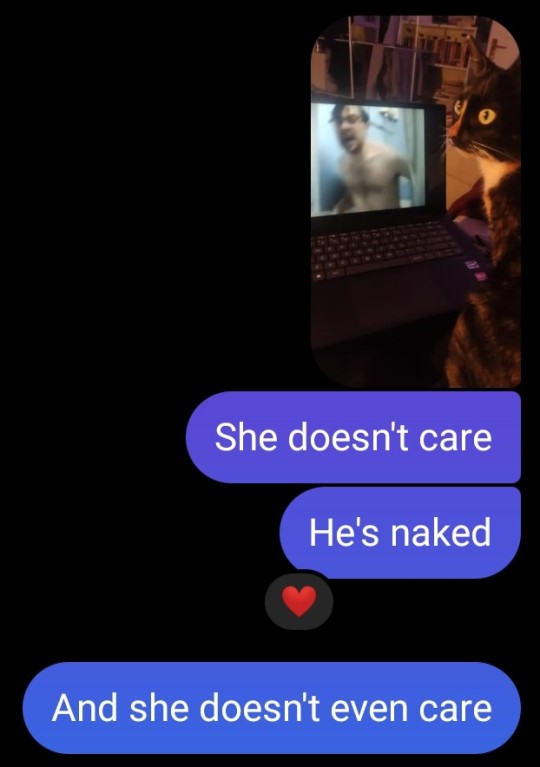
And the actual picture:
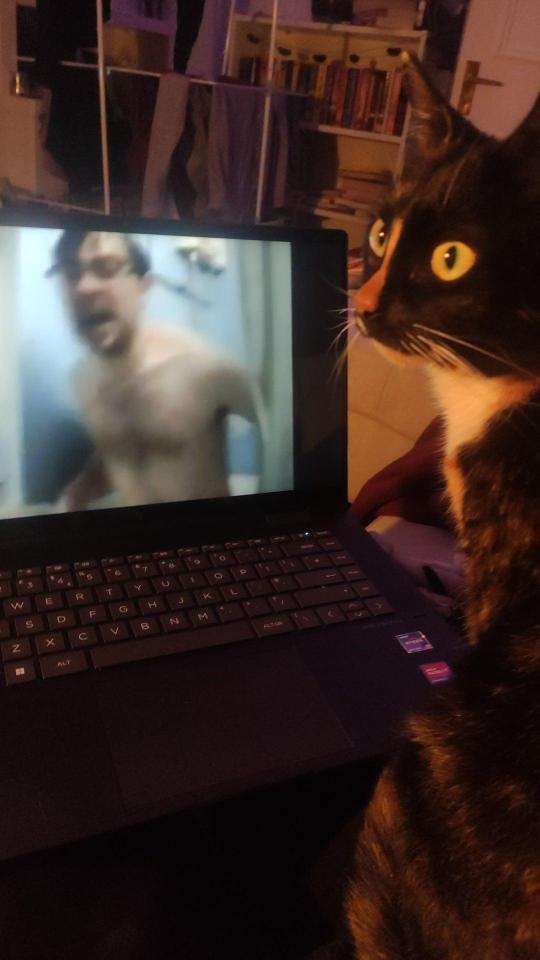
#highgate house of horror#reece fucking shearsmith#insane behaviour from all of them in this one absolutely incredible#the cats called cranberry btw#shes having a sleepover at ours
7 notes
·
View notes
Text

what is this outfit steve and why did you own it
#i realise this doesn't look like an 'outfit' because you can only see the vest clearly but if i posted the bottom half...questionable#i should actually rewatch highgate house of horror in full not just skip through with the sound off#one of them did not make their bed before filming#it's 30 years old can you believe
5 notes
·
View notes
Text
Alongside the new audio commentaries and an "anniversary featurette", the six-disc Blu-ray also includes outtakes and deleted scenes; a 2002 radio interview of the group by producer Paul Jackson from his In Conversation With Radio 4 series; an interview with the series' composer Joby Talbot, plus the 1995 short Highgate House Of Horror, a precursor to the television series comprising three stories, featuring usually off-screen member Dyson in an acting role, shot in Pemberton and Shearsmith's flatshare of the time.
#the league of gentlemen#mark gatiss#reece shearsmith#steve pemberton#jeremy dyson#article#blu ray#British comedy guide
12 notes
·
View notes
Text
James Lovegrove’s Sherlock Holmes books
James Lovegrove has written a ton of Sherlock Holmes books over the years (all Victorian era/canon era). I recently came across his latest series on the Hoopla app while I was browsing audiobooks that were available and the cover art totally roped me in. I ended up reading all three books in the newest series, all the Cthulu casebooks and a few in his earliest series. As far as I can tell, his books seem to be split into three different series based on the structure of the subtitles and the different cover art. I enjoyed all the books I read by Lovegrove for different reasons, but as I've already established in my other book rec posts, I mostly only care about the Holmes/Watson dynamic. So listed below are Lovegrove's Sherlock series in chronological order, which also happens to be, in my opinion, the order from least to best Holmes & Watson dynamics •ᴗ•
━━━━━━━━━━━━━━━━━━━
The New Adventures of Sherlock Holmes by Titan Books Series, 2013-2018
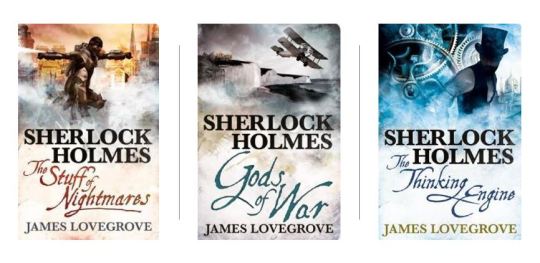
I honestly just realized while researching links for this post that Lovegrove's books in this series are part of a bigger series with multiple authors (lol me), so I'm not going to list all the titles here, but they've been published from 2011-2023 and Lovegrove has written six of the 21 books. The other authors in the series are Guy Adams, George Mann, Cavan Scott, Mark A. Latham, Nick Kyme, Philip Purser-Hallard, and Tim Major. I read the first two Lovegrove books in this series last after reading his other SH series and the stories were pretty solid. One of them was a WWI-era story, which is a time period that I love to read about. The only thing I will say is that the Holmes & Watson vibe is a little too I'm-smarter-than-you-do-keep-up for my taste, which is why I took a break after reading the first two. But I wouldn't be against dipping back into this series at some point in the future and also checking out what the other authors have to offer.
Goodreads series page (x)
━━━━━━━━━━━━━━━━━━━
The Cthulu Casebooks, 2016-2023
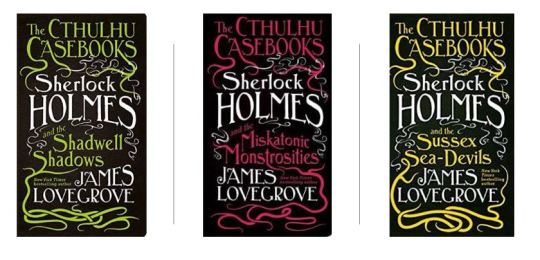
There are four books in the Cthulu Casebooks series and the framing device is that James Lovegrove himself is a descendant of H.P. Lovecraft, which is how he comes into possession of Watson's secret writings on his and Sherlock's real adventures going up against Cthulu and other eldritch horrors. These books are not just a romp through a mashup of literary worlds, there are very real stakes and things get dark. I really liked these books, I'm not really a Lovecraft fan at all, but I have read some of his works and of course I'm aware of all the elements from his works that have transcended their stories and are really a part of general fantasy/horror fan knowledge. My best friend is a huge Lovecraft fan and we read these together, so they were able to tell me how precise the Lovecraftian elements were -- they were precise -- so Lovecraft fan approved. The framing device was my favorite thing, especially the author's note at the end of book three, which was a very bone-chilling way to end the book (that I was listening to on audio in my dark house at night -- oops).
Sherlock Holmes and the Shadwell Shadows
Sherlock Holmes and the Miskatonic Monstrosities
Sherlock Holmes and the Sussex Sea-Devils
Sherlock Holmes and the Highgate Horrors
Goodreads series page (x)
━━━━━━━━━━━━━━━━━━━
James Lovegrove's Sherlock Holmes, 2019-2021
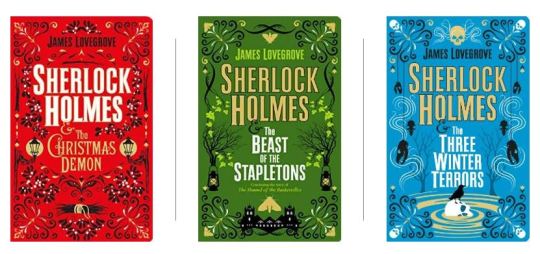
This was my favorite series out of the Lovegrove set and also the first that I read. I felt like the Holmes & Watson dynamic was especially great -- and for me that means: they felt more like equals, there was just the right amount of bickering, and they cared deeply about each other. While I was reading these I took some short notes to help me remember what was special about each book, here they are below next to the titles. I would say that the covers and titles make the series seem like it might have fantasy elements, but it's more like they are debunking their clients outlandish theories before getting stuck in on the actual case.
Sherlock Holmes & the Christmas Demon (has a Three Garridebs-esque scene; Holmes dresses up as Santa!)
Sherlock Holmes & The Beast of the Stapletons (a continuation of HOUN complete with a short estrangement of Holmes & Watson)
Sherlock Holmes & The Three Winter Terrors (the dedication at the beginning of the book is to Jeremy Brett ❤)
Goodreads pages (x) (x) (x)
Here’s my goodreads shelf with all kinds of Sherlock Holmes books that I’ve read or am hoping to read. Let me know if you have any recs! And check my pinned post for other book recs posts!
39 notes
·
View notes
Text
Finally caught up and watched HIGHGATE HOUSE OF HORROR last night. Adding the title to my r/in9/etc Note I realized this was the last TLOG-related thing I hadn't watched, so therefore this branch of my in9 + extended universe journey seems to have ended. although there's some BTS/general press stuff I haven't gotten around to
Really liked all the film references! Happy to have gotten PSYCHO, DON'T LOOK NOW (ofc), and I wanna say TRILOGY OF TERROR, THE OMEN, and THE SHINING? I'm sure there are others that went over my head.
I'm admittedly not the biggest horror film fan, but I love how much the League love it (and just cinema/television in general!), and I've certainly tried to watch more from this genre ever since watching the show. last time this happened was during my SCREAM phase a few years ago...
And Steve & Jeremy were so good!!
Also glad to have known what Branston was because of Three Bean Salad lol
#film diary#tlog#league of gentlemen#the league of gentlemen#jeremy dyson#mark gatiss#steve pemberton#reece shearsmith#experimenting with writing stuff out rather than just reblogging frames/gifs although that's fun to do as well#vagueeyes.pdf
18 notes
·
View notes
Text
The screaming staircase reread
notes made whilst reading my paperback copy of the book
also the foreward where Stroud talks about the show and his first image of the story has me feeling so many things (I love this bookmark so much)
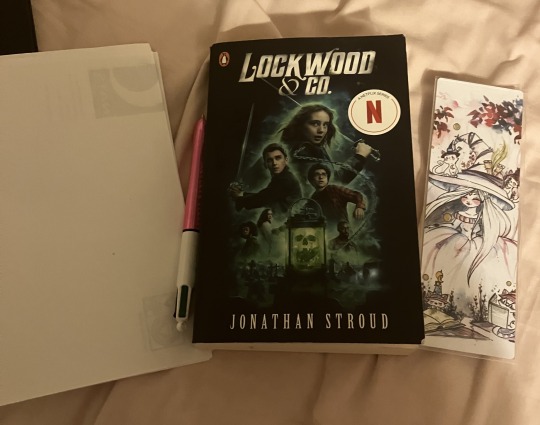
16th October 2024
3 I love the opening
4 Lockwood’s sillyness
5 “I spied a movement: something shifting in the halls black depths”
6 “all the usuals emotions featured” glad that the law states part was give to Lockwood in the show
9 “when entering the house…” I love this bit and the house description and “halls, landings and staircases are the arteries and airways of any building”
Bright death-glow, the landing on top feeling would never come across on screen “then we find ourselves a ghost”
15 ‘It’s the simple things that matter most”
16 “already checked everything back in the office’ did you though?
17 “lamplight glimmered darkly in his flop of hair” and “irony is cleverer”
17th October 2024
19 Harry Crisp
20 “she felt as if something was looking for her, that it knew she was there, but couldn’t find her…”
23 “a nail being hammered into wood” love the implications for this because how would Annie know the process of what Fairfax did to conceal his crime?
27 “scary things with your eyes” don’t blame George
29 “I saw a girl sanding there”
31 I love the terms being explained even though we have a glossary
33 Lucy’s sing song voice
37 Iron to the face.
40 “It’s my responsibility”/ “to make bad decisions?” Lmao “Sun coming out, Lockwood’s glare softened to a grin”-> what tipped you off that Mr Hope was a geologist?
47 knocked the filings
51 “She was prettier than me”… “she looked to be like the kind of girl I’d always instinctively disliked” internalised misogyny Ding! Ding!
53 description of body
55 “would you call that even the slightest bit controlled? Nope I would not”
18th October 2024
57 the locket! I love this description
60 “sooty grin”… “suspended together between heat and cold”
66 Highgate Terror and the Mud Lane Phantom
68 the terror of the abuse not being finished with death… seven girls? Lucy is baby
72 Penny Nolan + pretty field of flowers
73 mustard coloured jackets and first sunrise corporation
74 Fittes Manual for Ghost-hunters; all sisters apart from Mary left home; advancement and ambitions; all her team died as “Jacob began to lose his nerve” (you know in the show they changed the name to Moorgate Mill? Real place in Wessex apparently)
80 “more accurate” piss off and an update on what happened to the mill and leaving for London
19th October 2024
84 corner shop my love
87 Umbrellas, walking sticks and rapiers
88 Lockwood smile, green and white spotted handkerchief “Almost here”
90 Murton Colliery Horror
92 “when he smiled at me, a warm light seemed to suffuse the room”
97-98 blessed scene- did the Skull first and the three (good, bad and indifferent) at the same time
100 “don’t care wave”
104 attic and more books
106 I love this bit in the show with the gag of Lucy pushing the lid and revealing the insult (It would have been funnier if George called Lockwood out on the time change or cases messed up)
108 Joe and Esmeralda (their namesakes Marissa’s ghosts) we can have them in the show it would just be them getting repaired
110 Uncle Lockwood- Hey Kensal Green!
112 I love Lucy talking about Lockwood and complaining about George
115 “Walking into darkness with Lockwood at my side”
119 dismissing his grandchild Lockwood’s pointed questions (spiders attracted cats repelled)
124 Clever Lucy wish we could have seen this scene in the show
128 love Cameron delivering this line in the show “you’d think…” love the talk about George
Part three the Necklace
133 “like dragon scales”
135 I wish this scene was in the show. Lockwood talking to Lucy and telling her they're going to the hospital. Alas we might have got it if Netlflix wasn't allergic to anything more than eight episodes (or the episodes were longer)
138 “adrenalin in the ambulance and stopped the rot”
140 Lucy don’t be dense hate this scene
143 how big a reward? Is it still applicable?
146 I am so glad this storm cleared
20th October 2024
153 “Barnes liked the rules more than most”… “inexpressibly old”
156 four weeks to two in the show and Barnes dissmissal of other cultures (so really upping the stakes in the show)
158 “it’s easily started by grotesque shapes” George!
160 now people cancelled the cases… did she?
165 “I messed up and disaster followed”
168 ghost-fog is so cool and Annie is so creepy here
172 “the smiley giraffe” 173 George is so funny
180 "maybe I just wanted to save something of her, so she wouldn't be completely lost..."
183 "this necklace is more significant to Annabel Ward than her own bodily remains..."
185 wanting to save Annie... how hot was the Sheen Road fire?
191 Lockwood requests and asks her to connect with Annie's memory
195 "marks of their profession and status"
200 here here George "I say it's a crime to refuse free food"
201 Gibbet hill?
203 Lockwood's wolf like smile
205 the moment that sparked a number of questions all boiled down to did Kipps know Jessica and like her? (personally I think they were friends)
207 Love this bit "almost got it Kipps" wish we got to Jack Bandeira jump around a bit in the show
209 a note of when this begins again Hugo Blake is 100% guilty
216 I want a mint
218 "doesn't really add anything" LOCKWOOD WHAT
219 Lockwood's aesthetically long coat hindering him again
21st October
222 casually threatening children
225 "she was so radiant it was like the other-light was already on her"
232 potential murderer
237 "this was our house, our home"
240 I like the change in the show "can I offer you some tea" intruder using the ghosts as distractions and weapons
255 Compliments on ghost-wards
258 ingratiation with the trio
265 missing boy of the Fittes team :(
271 George and Lucy team up
273 Lucy's scary eyes
278 "obviously guilty" HOW? (I really want to know Lockwood's thought process as it so obvious that he was suspecting Fairfax quite early on)
282 the Skull? "talking quietly in the next room" (when Lucy is showing Annabel the group* picture) I wonder how this story would have changed if the Skull was heard by Lucy earlier on? how many more insults would we get?... as I was typing this up I came to ask myself am I the Skull? when reading this book? and the answer might very well be yes
*good idea she should have got a copy and cut it up and just showed the other people one by one see what happens
284 worried Lockwood is my favourite
287 *sarcasm* I wonder who else is in the picture
22nd October 2024
289 Lmao Lucy
291 dear Cousin Throckmorton (i had the exact same reaction the first time I read the book)
292 ululation is a word I forgot the meaning of (and all I could think looking at it is Jeff Wayne's War of the Worlds)... I love a map... blackface of course the crimes Fairfax has commited is varied for sure
294 "not really relevant" but isn't it though? not a thought in this girls head honestly
302 "Lucy's terribly jaded"
309 "the house was just the gate"
313 Lockwood's customer service voice must be great. It has to be.
315 another puzzle piece
320 "we worked together" a well you say? well, well, well
324 Lockwood talking about what type of man Fairfax is "a dreadful one isn't it obvious?" to me? Yes both times I've read the book and even without watching the show first. George and Lucy however? not so sure it is
23rd October 2024
328 disconcertingly bright death-glows
332 "I didn't like it's face"
334 clever George
337 Lockwood not believing in the Screaming Staircase
345 hello smell of blood
347 more bright death-glows
348 "It looks like blood, it smells like it. it'll do as blood for me" (I like the show altering this line a little bit to make it run better)
353 lmao Lockwood "You're a girl aren't you meant to be more sensitive"
362 those poor cats- hey Lucy does have a brain it just took a minute to catch up
365 poor little boy "his other-light lit nothing but himself"
368 I love this converstation and Lucy being pleasant about it
372 "Lockwood was too good a leader to ignore so strong a warning"
377 "it had come from the locket... A burst of energy" Aw Annie is trying to help
378 Lockwood "No Lucy, that's not the way it's going to be"
385 funny George... don't worry Lucy will slap Lockwood you just have to wait a bit
386 Castle Sherbourne? 388 Lockwood noticing the smoke
389 Fairfax a self made man my aunt fanny
393 "Don't give me that. You had no idea" George might have actually and just didn't share it like Lockwood did
394 "she was an actor too... she'd had a promising acting career, but had given it up because of... something or other"
400 Lockwood is cool, calm and collected
402 "feel free to shoot the girl' Lockwood said something, but I didn't hear what" okay what did Lockwood say?
406 "pretentious, self-regarding sort of fellow"
407 "Will Fairfax" the acting name but Will Fairfax ever grow up?
409 "passion between them" concealment and performance of secret relationships...
412 Forgot? Good for Annie though
413 Clever Lockwood sending a message to Barnes (also why did DEPRAC show up in the show?)
415 Grebe seeing and recognising the silver glass and going "uh oh"
421 Starkins being spooked by DEPRAC is so funny
424 Barnes is so great "in keeping with tradition, Inspector Barnes managed to remain deeply annoyed with us while grudgingly congratulating us on a job well done."
425 Lockwood defending his choices and the "fullest most radiant smile" is so great
427 prep school nice (have fun kids)
428 Sad "His name was Sam McCarthy. For the record, he'd been twelve years old." (I do love the show for having Penelope approached and thanked the trio personally and having them attend the funeral as well)
431 party time hello "harp"
433 "we met each others eyes, smiled, and looked away"
435 I LOVE Lucy telling Lockwood about the Mill Incident
437 I giggle quite a bit at Lucy going "I don't need lights" and immediatly trips over a box
439 Lucy has no time for your nonsense
440 Lockwoods laugh and how well Lucy knows him "He'd thrown his head back, I could tell"
#lockwood and co#george cubbins#anthony lockwood#lucy carlyle#the screaming staircase reread#lockwood library#if i repeat myself then sorry#I know there's a readathon going on but bit late for that with the first book
13 notes
·
View notes
Text

March Wrap Up!
My favorite of the month was Project 562: Changing the Way We See Native America. Small Country, Wicked Like a Wildfire, Kalyana, and Surf War! checked off Burundi, Montenegro, Fiji, and The Marshall Islands respectively for my Read the World Challenge.
The Daughter of Danray by Natalia Hernandez- 4⭐️
Runaway: The Daring Escape of Ona Judge by Ray Anthony Shephard- 5⭐️
Black Butterflies by Priscilla Morris- 4.5⭐️
The Night Masquerade by Nnedi Okorafor- 4⭐️
A Dangerous Trade by Cassandra Rose Clarke- 3⭐️
The Berry Pickers by Amanda Peters- 4.5⭐️
The Night Guest by Hildur Knútsdóttir trans by Mary Robinette Kowal- 4⭐️
Witches Abroad by Terry Pratchett- 3⭐️
All Your Children, Scattered by Beata Umubyeyi Maireesse trans by Alison Anderson- 3.5⭐️
Desperate Hours by David Mack- 2⭐️
Pride and Prejudice by Jane Austen- 5⭐️
Forever Autumn by Mark Morris- 2⭐️
Small Country by Gaël Faye- 4⭐️
Mis(h)adra by Iasmin Omar Ata- 5⭐️
The Haunting of Hill House by Shirley Jackson- 3⭐️
Lords and Ladies by Terry Pratchett- 4⭐️
Imago by Octavia Butler- 3⭐️
Wicked Like a Wildfire by Lana Popović- 4⭐️
Watchmen by Alan Moore et al- 4.5⭐️
Kalyana by Rajni Mala Khelawan- 4⭐️
Hogfather by Terry Pratchett- 4.5⭐️
The Flicker by HE Edgmon- 5⭐️
If They Come in the Morning: Voices of Resistance by Angela Davis- 5⭐️
Project 562: Changing the Way We See Native America by Matika Wilbur- 5⭐️
A Guest in the House by EM Carrol- 2⭐️
The Guy She Was Interested in Wasn't a Guy at All Volume 1 by Sumiko Arai- 4⭐️
Star Trek Volume 1 by Mike Johnson et al- 2⭐️
Surf War! A Folktale from the Marshall Islands by Margaret Read MacDonald and Geraldo Valério- 4⭐️
Rabbit Chase by Elizabeth LaPensée illustrated by KC Oster trans by Aarin Dokum- 5⭐️
Maskerade by Terry Pratchett- 2.5⭐️
Doctor Who: The Highgate Horror by Mark Wright et al- 3.5⭐️
Teen Titans Vol 3: Beast Boys and Girls by Geoff Johns et al- 1.5⭐️
Surviving the City: From the Roots Up by Tasha Spillett and Natasha Donovan- 4.5⭐️
Eve: Children of the Moon by Victor Lavalle, Jo Mi-Gyeong, and Brittany Peer- 4⭐️
3 notes
·
View notes
Text
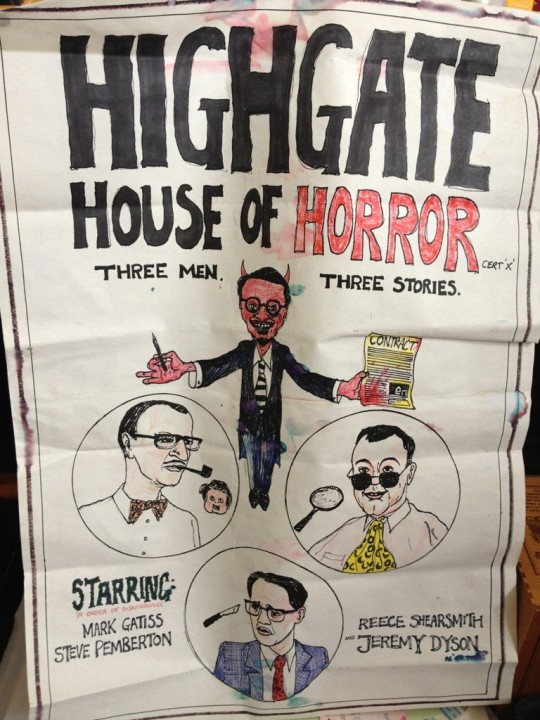
Reece's poster for Hightgate House of Horror, the homemade portmanteau horror film the League filmed in Steve & Reece's Highgate flat.
58 notes
·
View notes
Text
places i have been because of the league of gentlemen:
• bfi (for no9 previews)
• wyndham theatre (stage/fright)
• bretton hall (technically just saw it from behind a fence)
• south close (home of the flat where highgate house of horror was shot)
• old operating theatre (xmas special)
• soho square (tlog: apocalypse)
• canal cafe (we couldn’t get upstairs because there were rehearsals on so we sat and had an awkward expensive drink in the bar. gutted cos i wanted to see the stage)
• leeds (though my mum didn’t want to go to the park where one of jeremy’s stories is set. her loss!)
• outside the front of euston station (like geoff tipps)
• leicester square theatre (jeremy podcast recording)
• skanky bristol odeon (watched see how they run 😖😴)
places i have not been:
• hadfield, weirdly
4 notes
·
View notes
Text
Why I like Asylum's Monster Mash (a list)
I'm starting to feel that the Asylum mockbuster Monster Mash is my favorite movie of 2024 (So far) and might retain that status. This is odd since the movie is deliberate direct-to-streaming, low-budget Schlock from The Asylum film studio. I actually liked it more than Abigail.
So I have decided to analyze why I like this movie.
1. It doesn't try to be high art. It just tries to tell a fun, spooky, story. 2. The character portrayals are surprisingly likable, from making Dracula the lead protagonist, a monster Tony Stark, to the subtle indications that Dracula probably could have handled all of this himself but he's secretly lonely and liked the excuse of having the other monsters at his side. It's adorkable. I love hero-Dracula. 3. The many delicious nods to the classic Universal monster movies from naming the Frankenstein Monster Boris (which is also a possible nod to the Monster Mash Song that was referencing the Universal Monster movie actor Boris Karloff), Dracula's daughter being implied bisexual like she was in the 1936 Dracula's daughter movie, the one scene deliberately using the eye lighting effect from the original Bela Lugosi Dracula, and thanking the creators of the Universal Monster movies on the end credits. And there were other delightful tropes and plot points.
4. The sense that the story is set in some surreal fairy-tale like, timeless, otherworld from Dracula's mid-nineteenth century fashion, to Elizabeta's slave girls wearing modern-ish evening gowns, to the medieval peasant girl costumes in the tavern, to The Invisible Man wearing 1930s black goggles, and a 20th century turtleneck shirt. 5. You have a desert cave, a Louisiana style swamp house (Home of the werewolf, who has a Southern-American accent), snarky Invisible Man who talks like Larry from Doom Patrol, and mentions of Turkey and Highgate cemetery and Candlewood Village all sounding weirdly close to each other. It's a bit disorientating until you think of it like it's own other world like Castlevania, or a Hammer horror movie, or The Enchanted Forest from Once Upon a Time. 6. I think of it as an alternate Universe version of Earth, on a continent (Europe-like despite the many American accents) where all the classic Gothic stories are true and co-exist. 7. The lack of specific time period and implied different cultures being in relative close proximity to each other amuses me.
8. The slightly off-putting but comical pause near the end to warn us that the scary part is coming, right before the really fake looking monster fight.
9. The strange contrast of the Dracula actor apparently giving it his all while the Dr. Frankenstein actor is barely acting and apparently phoning it in. The Asylum doesn't deserve this Dracula. He's too good for them. 10. For an asylum mockbuster it has a surprisingly diverse cast of characters and actors. Dracula, his daughter, a witch, a zombie, a mummy (played by a man actually from North Africa), werewolf, and The Invisible Man. I kind of hope the sequel (if it gets a sequel) is set on the high seas to allow for pirate ghosts (another fun trope) and The Creature from the Black Lagoon equivalent character. 11. Because Asylum is known as schlock I sometimes think a lot of the continuity errors and minor mistakes are deliberate (i.e. the misspelling of Nightmare on the trailer) which can be annoying but I found the movie charming enough to over look the apparent "deliberate" badness. 12. I could easily come up with joking call lines for this thing even though it's no Rocky Horror. (For starters it's not a musical.) 13. There's a surprisingly catchy theme song from the woman who plays Dracula's daughter. 13. I strongly feel this is the direction they should have gone with the Universal Studios Dark Universe.
#The Asylum#The Asylum films#The Asylum studio#The Asylum Pictures#Syfy original#Syfy#Monster Mash#Dracula#Frankenstein#Universal Studios#Universal's Dark Unierse#Universal Dark Universe#Dark Universe
3 notes
·
View notes
Photo








Steve Pemberton in Highgate House of Horror
19 notes
·
View notes
Photo
I've never seen this but now I must find it.
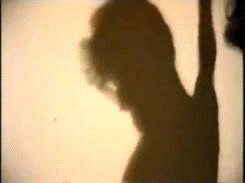
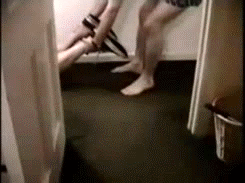
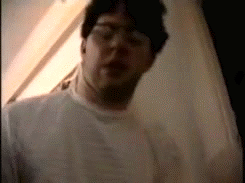
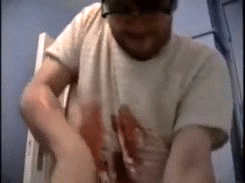
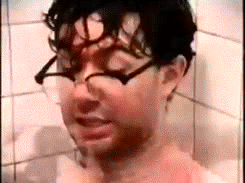

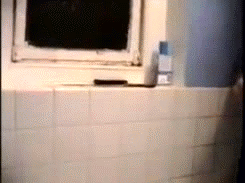
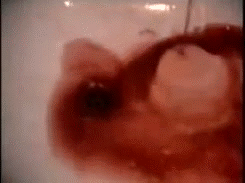
The League of Gentlemen: Highgate House of Horror (x)
The most shocking shower scene since Psycho!
217 notes
·
View notes
Photo
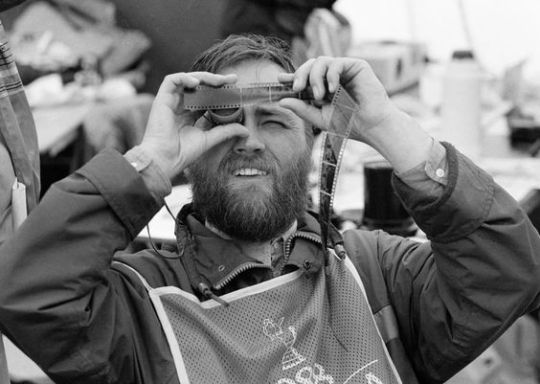
Eamonn McCabe, who has died suddenly aged 74, was a photographer, photo editor, educator and broadcaster, and served as the Guardian’s picture editor for 13 years. And when he wasn’t shooting, editing or talking about images, he was collecting awards for doing so. His work won him picture editor of the year an unprecedented six times and sports photographer of the year four times, creating groundbreaking photographs for the Observer. From his early pictures, such as one of a table tennis player with a very high throw, or an image of Björn Borg’s gimlet eyes on a tennis ball, it was recognised that Eamonn, like Borg, had his own way of perceiving the world. He was bringing something different to sports photography and his trophy cupboard started to fill.
In 1985 he won news photographer of the year for his photographs of the Heysel stadium disaster in Brussels. He was there to cover a football match, but sport was forgotten when the tragic events unfolded. He said that witnessing this horror had a lasting effect on him and perhaps hastened his departure from sports photography. “I went as a sports photographer, thrilled to be covering Juventus against Liverpool, and ended up a news photographer, as the whole thing turned into a terrifying disaster in which 39 supporters were killed … I never processed the films from the game itself. They didn’t seem to be very important.”
Editing pictures became the route out of weekly witnessing English football at its worst, and in 1988 Eamonn was recruited as picture editor of the Guardian by its then editor, Peter Preston, to help the paper see off the new Independent with its well-printed photography. Eamonn’s unique way of seeing and framing the world worked as well behind a desk as behind his cameras. He understood how a news or feature photograph is used and cropped is often as important as its content.
Eamonn was born in Highgate, north London. His father, James McCabe, was a taxi driver and his mother, Celia (nee Henchy), a hotel receptionist. They went on to open a hotel in Manor House opposite Finsbury Park. The young Eamonn grew up among the same postwar streets as another photography great, Don McCullin. At Challoner school in Finchley, it seems he spent most of the time playing football and boxing – he left school with just a couple of O-levels. He started work in a solicitor’s office, then in the accounts department of a brewery, but ledgers and spreadsheets were not for him and he got a job as a junior in an advertising agency. A previous incumbent of his lowly position had been David Bowie.
After a couple of years he got the travel bug, left the ad agency and headed to the capital of flower power in the 60s, San Francisco. He enrolled for a film-making course, but discovered a love for stills photography rather than movies. Eventually he had to leave – with the visa he held, he was in danger of being sent to Vietnam. But first he had a Rolling Stones gig to go to: “Mick Jagger laid on a free Stones concert on 6 December 1969 at the Altamont Speedway, northern California. Three hundred thousand people turned up. I had my cameras and pushed my way upfront to the tiny stage that had been hastily produced. By most accounts, the Hells Angels were hired as security for $500 worth of beer. If Woodstock was the dream, Altamont was the nightmare – the stage was much too low and the Angels didn’t like the sight of nudity and weighed into the crowd with snooker cues. A big guy next to me got the worst of it and I just ran. You don’t argue with the Angels high on beer.”
Returning to the UK, he worked in the photo unit of Imperial College, followed by a job with the London Photo Agency (LPA). He worked in the darkrooms and took pictures at rock concerts. This was a far more exciting world for a 23-year-old. Eamonn said: “The Rolling Stones, the Who, the Beach Boys – they were our heroes. Theirs was the music we listened to anyway ... there was a rawness about them that made good pictures.”
However, in the LPA building, there was another picture agency, Sporting Pictures, where Eamonn got some shifts shooting football matches. He had always been keen on sport, specifically football, and he was a lifelong Tottenham Hotspur fan. Like many sports photographers, if he hadn’t been sent to an event to take pictures, he might well have been there as a fan.
In 1974 Eamonn decided to set up his own picture agency in north London – working for the local papers in the area, but crucially shooting all the home matches of the north London rivals Spurs and Arsenal. He distributed pictures to the national papers. Within a couple of years he landed a contract with the Observer. The paper allowed and encouraged him to develop a style – what became known as “an Eamonn McCabe picture” – a different angle, perhaps away from the peak of the action; a detail; something graphic; a strong use of black and white; a touch of humour. The Guardian’s sports photographer Tom Jenkins said: “Formal shape and a whimsical sense of humour played a large part in McCabe’s sports work, like his picture of the bald Bristol City goalkeeper John Shaw looking like he was about to boot his own head into the centre-circle. Eamonn was always on the lookout for something different.”
According to Jenkins, a picture of the boxer Sylvester Mittee wrapping his hands with bandages before a training session is a prime example of this: “A close-up moment that probably no other photographer at the time would have bothered with.” Eamonn himself explained the choice of lens: “I grabbed a 180mm lens, quite long for indoor work, but it paid off. The effect was to throw everything out of focus except the bandaging and texture of his fingers.”
He documented just about every sport and covered three Olympic Games. And he photographed the wedding of Prince Charles and Lady Diana Spencer – as a sports photographer he was able to capture the kiss on the palace balcony with his long cricket lens.
The peerless sports journalist Hugh McIlvanney wrote of being Eamonn’s colleague at the Observer in a foreword to his first book, Sports Photographer (1982): “Working with Eamonn McCabe can be hazardous to a reporter’s ego. His photographs often convey the essence of an event or a performer with such dramatic succinctness that the writer assigned to the same job is left with the feeling of having turned in a 1,500-word caption.”
As well as shooting sport, Eamonn also played for an amateur team, the Nine Elms Dynamos: “One morning, when we were getting a real spanking,” he wrote, “a long-haired centre forward scored yet another goal and ran back past me as I was lying face down in the mud: ‘You didn’t get a picture of that one, did you?’”
After Heysel, Eamonn was offered his first picture-editing job, on a new magazine, Sportsweek. It seemed a perfect journal for the move from shooting to editing photography. Unfortunately, the proprietor was Robert Maxwell. It was a good product with great photography, edited by Eamonn, but it lost money and Maxwell soon tired of the losses. The Guardian needed a new picture editor. Perhaps an award-winning sports photographer with very little editing experience might not have been everyone’s choice, but Preston knew it could work.
Paul Johnson, until recently deputy editor of the Guardian, said that Eamonn “transformed the look and feel of the newspaper almost overnight. Some senior colleagues felt the photographs were just too big and were squeezing out words, until gently reminded, with a smile, that no reader had ever complained about the lack of words in the Guardian (the wrong words, yes, all the time, but not lack of them).”
Eamonn recruited new photographers and ensured that photography was not an afterthought. He got his picture choice printed on 20in x 16in paper by the Guardian darkroom and argued hard for his selection in news meetings. Johnson said: “Eamonn had a compelling visual literacy but also warmth and charisma. People loved working for him, people loved working with him.”
Eamonn was in his element as the Guardian covered the big news events that seemed to come with increasing frequency at the time – the downing of the Pan Am plane over Lockerbie, the Clapham rail crash, the fall of the Berlin Wall, the death of Diana, Princess of Wales.
In 2001 Eamonn decided to “go back on the road”. He had a need to create his own images. He stayed on at the Guardian, but this time shooting something a bit quieter: portraits. He photographed many notable people, from Tony Blair to Iris Murdoch, Lou Reed to Desmond Tutu. The Guardian feature writer Simon Hattenstone said: “Eamonn was astonishingly quick, he never panicked, and he was fantastically unobtrusive. Often the photo was done before the subjects had time to smile or stiffen up.” He favoured a direct approach with his portraits. He liked his subjects to confront his camera and, by extension, the viewer.
Many of these photographs are in the National Portrait Gallery collection. He also photographed artists and their studios for the Guardian and the Royal Academy magazine, including Frank Auerbach, Grayson Perry, Bridget Riley, Howard Hodgkin and Maggi Hambling.
Eamonn was keen to pass on his knowledge and inspire others. A steady stream of hopefuls brought portfolios to his desk, where he dispensed advice and encouragement. His educational work extended to TV programmes such as Britain in Focus (2017) for the BBC. He was often chosen by the broadcast media as a photo pundit – he was recently interviewed about imagery of Queen Elizabeth – and his relaxed manner and thorough knowledge made him a natural on TV or radio. He published six books – the last one, on aerial photography, demonstrates the breadth of his photographic knowledge.
As well as honorary professorships at Thames Valley (Preston responded to the appointment by nicknaming him “Prof”) and Staffordshire universities, Eamonn was visiting senior fellow in photography at the University of Suffolk and held an honorary doctorate from the University of East Anglia.
He moved to Suffolk a few years ago and immediately got involved with photography in the county. He taught at the university in Ipswich and when PhotoEast – the Ipswich-based photo festival – was founded, Eamonn was asked if he would become the patron. He agreed without question.
Eamonn was always a dapper dresser and, once he had left his sports photographer’s waterproofs behind, his tweed coat and jaunty hats looked the part in the small town of Saxmundham where he lived. Although he was a Londoner who enjoyed the pubs, jazz clubs and art galleries of the city, life in the country gave him land- and seascapes to photograph and a vegetable garden to tend. He swapped soccer for golf – he played a round two days before he died.
On hearing the news of his death, Eamonn’s erstwhile neighbour McCullin said: “McCabe was like all great photographers – he never stopped working. Like most of us, his life was photography.” The answer to which is one of Eamonn’s favourite sayings, “It’s better than working, Rog”.
In July 1997 Eamonn asked Rebecca Smithers, a Guardian journalist, to marry him while they were on a press trip to New York – they were married at City Hall a couple of days later. He is survived by Rebecca and their daughter, Mabel; by Ben, his son from a previous marriage, to Ruth Calvert, that ended in divorce; and by Marian, his sister.
Alan Rusbridger writes: The email from Eamonn McCabe popped into my inbox just after breakfast one day in the spring of 2009. “What is it with X [here was the name of an internationally acclaimed fashion photographer whose work had been featured in that day’s Guardian]? I don’t get it. That photograph (?) of Y [here was the name of the subject in the offending portrait] has to be one of the worst we have ever printed ... I spent years trying to get that sort of crap out of the pages. What next, handshakes and big cheques?”
I revisited the image this week. It was, indeed, sensationally bad – poorly lit, awkward shadows, overexposed, lazily composed, clumsily cropped and barely in focus.
I don’t think Eamonn was bitter about the prices his fellow lensman could command (upwards of £40k for a plate). More likely, he felt puzzled – and, on behalf of press photographers the world over, a bit insulted. As a former picture editor, he knew that a dozen or more staff or freelance photographers – none of them remotely household names – would have come up with a better photograph given five minutes and a bare wall.
Eamonn was a press photographer to his fingertips. As a sports photographer on the Observer, he had lightning reactions and an instinctive eye for composition. Even if you didn’t know the name, you’d recognise many of the iconic images from his years on the touchline.
The former Times writer, Simon Barnes, wrote of his images: “People in sports journalism talk about an ‘Eamonn McCabe shot’ even when McCabe did not take the picture. They are talking about a style, a vision, a way of looking at sport.”
It was an inspired move when my predecessor as editor of the Guardian, Peter Preston, hired Eamonn to be picture editor in 1988 – the time of a crucial redesign. The paper had always employed distinguished staff photographers, but they were often let down by the quality of printing and by lacklustre design. Eamonn did, indeed, ban the “crap” – especially the cliched picture that told you nothing. He favoured the bold, the unexpected – images that not only caught your eye but lingered in the mind. He was encouraging to young photographers; always approachable … and always up for a pint or two at the end of his shift.
He was a late convert to the power of colour – once railing against the distracting glare of hi-vis jackets in an image of rescue workers at a train crash. But, in time, he came to accept the inevitable.
And then, remarkably, he had a third career (via a flirtation with landscape) as a portrait photographer, usually illustrating the culture pages’ profile of distinguished writers, artists and musicians. Unlike some internationally acclaimed photographers he could mention, he might only be given a few minutes and inadequate light in which to bag his shot. Nine times out of 10 he memorably and sensitively captured his subject.
It’s difficult to think of a comparable figure in photography – one who successfully crossed genres and who also had a spell generously editing the work of his peers. He was also one of the warmest and most collaborative figures in Fleet Street.
“Journalists are far too bashful to refer to any of their newspaper work as ‘art’,” wrote Barnes in an introduction to Eamonn’s work in 1987. Hence, perhaps, Eamonn’s snort of derision for the picture in the Guardian back in 2009. But Eamonn was truly a kind of artist, as well as an unpretentious pressman. He was a very rare thing.
🔔 Eamonn McCabe, photographer, born 28 July 1948; died 2 October 2022
📷 Photo above: Eamonn McCabe looking at his negatives in the press room during the 1988 British Open Golf Championships in Lytham St Annes.
Daily inspiration. Discover more photos at http://justforbooks.tumblr.com
10 notes
·
View notes